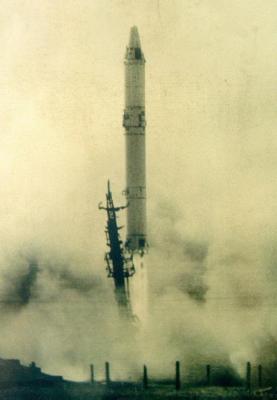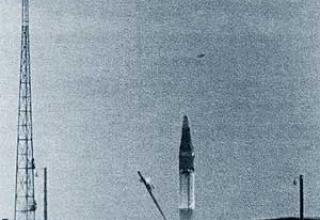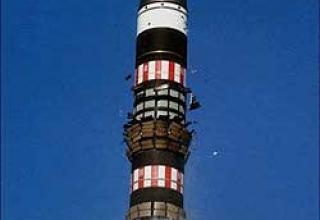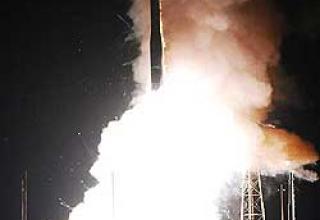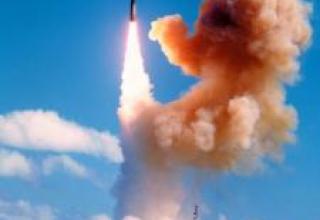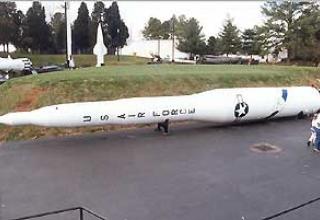The development of the R-36 strategic missile complex with the 8K69 orbital missile on the basis of the 8K67 intercontinental ballistic missile was set by the Decree of the CPSU Central Committee and the Council of Ministers of the USSR of April 16, 1962. The creation of the missile and the orbital block was assigned to the OKB-586 (now Yuzhnoye; Chief Designer M.K.Yangel), rocket engines - to the OKB-456 (now NPO Energomash; Chief Designer V.V. Lenin). P.Glushko), control system - NII-692 (now Khartron Design Bureau; Chief Designer V.G.Sergeyev), command devices - NII-944 (now Research Institute for Scientific Research; Chief Designer V.I.Kuznetsov). The combat launch complex was developed in the KBSM under the leadership of Chief Designer E.G.Rudyak.
Orbital missiles as compared to ballistic missiles provide the following advantages:
- an unlimited range to engage targets out of reach of intercontinental ballistic missiles;
- the ability to engage the same target from two mutually opposing directions, forcing a likely adversary to create a missile defense from at least two directions and spending significantly more money. For example, the defense line from the northern direction, Safeguard, cost the US tens of billions of dollars;
- the shorter flight time of the orbital head unit compared to that of the ballistic missile head unit (when the orbital missile is launched in the shortest direction);
- impossibility to predict the area of the GHG charge drop when moving on the orbital segment;
- the possibility of ensuring satisfactory target hit accuracy at very long launch ranges;
- the ability to effectively override the existing enemy missile defence.
Already in December 1962, the conceptual design was completed, and in 1963 began the development of technical documentation and production of prototypes of the rocket. The flight tests were completed on May 20, 1968.
It was adopted by the Decree of the USSR Government on November 19, 1968.
The first and only regiment with 8K69 orbital missiles went on combat duty on August 25, 1969 at NIIP-5. As part of the regiment were deployed 18 launchers.
Orbital missiles 8K69 were taken off duty in January 1983 in connection with the conclusion of the Treaty on the Limitation of Strategic Arms (OSV-2), which stipulated the ban on such systems. Later on the basis of 8K69 missile the Cyclone missile family was created.
The NATO code is SS-9 Mod 3 "Scarp"; the US also had the designation F-1-r.
Composition:
Rocket complex - stationary, with ground nuclear explosion-protected mine launchers (SHU) and controls. Launching unit - mine type "OS". Launch method - gas-dynamic of slurry control systems. Rocket - intercontinental, orbital, liquid, two-stage, ampoule. Missiles combat equipment - orbital head unit (OHH) 8F021 with a brake propulsion system (TDU), control system, combat unit (BC) with a charge of 2.3 Mt and a system of radio technical protection OHH.
During the flight of the orbital missile are carried out:
- Turn the missile in flight to the specified firing azimuth (in the range of angles +180°).
- Division of I and II stages.
- Switching off the engines of stage II and separation of controlled GHG.
- Continuation of autonomous flight of GHP through the orbit of an artificial Earth satellite, control of GHP by means of the system of calming, orientation and stabilization.
- After separation of the GHF, correction of its angular position in such a way that by the moment of the first switching on of the radio altimeter RV-21 the antenna axis is directed to the geoid.
- After the correction of GHG, the orbital motion with the angles of attack O degrees is performed.
- At the estimated moment of time, the first flight altitude measurement.
- Before the second measurement brake correction of the flight altitude.
- The second flight altitude measurement.
- Accelerated GHG turn to the orbital descent position.
- Shutter speed for 180 seconds before descending from orbit to work out angular disturbances and calm GHG.
- Start the brake propulsion system and separate the instrument compartment.
- Switching off the brake propulsion system and separation (in 2-3 s) of the instrument compartment from the booster.
Such a scheme of the orbital missile flight and determines its main design features. They are, above all, related:
- availability of a braking stage designed to ensure the GHG launch from orbit and equipped with its own propulsion system, a stabilization automaton (gyro horizon, hiroverticant) and a range control automaton that issues a command to turn off the remote control;
- the original 8D612 brake engine (developed by Yuzhnoye SDO), running on the main fuel components of the missile;
- range control by varying the shutdown time of stage II engines and the start time of the TPU;
- Installation of a radio altimeter in the instrument compartment of the rocket, which performs a two-time orbit altitude measurement and provides information to the counting and solving device to produce correction of the TPU switching time.
In addition to the above, the missile design (see diagram) has the following features:
- The use of the respective 8K67 rocket stages as stages I and II with minor design changes;
- Installation of an ELIS system missile in the instrument compartment to ensure orientation and stabilization of the GHG in the orbital region of the trajectory;
- refueling and ampulsification of the fuel cell of the GHP at a stationary refueling point in order to simplify the launch facility.
Changes in the design of the I and II stages of the 8K67 ballistic missile when used in an orbital missile is mainly the following:
- instead of a single instrument compartment, a smaller instrument compartment and an adapter are installed on the orbital missile to accommodate the C.I.S. equipment. After placing into the design orbit, the instrument compartment with the LC equipment located in it is separated from the hull and together with the MHF, it performs an orbital flight until the brake engine 8D612 of the MHF control compartment is started;
- in the tail compartment of Stage II of the missile there are no false target containers and no anti-missile defense system;
- the composition and layout of control equipment has been changed and a radio altimeter (Chestnut system) has been installed additionally.
Based on the results of the flight tests, the missile design was improved:
- all connections of the refueling and drain lines of the rocket engines are welded, except for four connections of ampulsifying membrane plugs installed on the refueling and drain lines;
- connections of supercharging gas generators of oxidizer tanks of stages I and II with tanks are made welded;
- filling and drain valves are installed on the bodies of the tail compartments of I and II stages;
- the fuel drain valve of II stage is cancelled;
- flanges for detachable connections of diaphragm units at the entrance to TNA of main and steering motors are replaced by welded sockets or flanges for welding with trunk lines;
- at welding sites of units made of stainless steel with aluminum alloy tank elements, durable bimetallic adapters made of bimetallic sheet forming have been used.
Terms of duty of the missile - the missile is on standby in a fueled slide. Battle application - in any weather conditions at air temperatures from - 40 to + 50 ° C and wind speed at the ground surface up to 25 m / s, before and after the nuclear impact on the missile.
Characteristics:
| General characteristics | |
| Maximum firing range, km | infinitely within a single coil around the Earth |
| Firing accuracy, km | ±5 |
| Generalized reliability indicator | 0.95 |
| Launch time from full alert, mines. | 4 |
| Warranty period on combat duty under the regulations once every 2 years, years | 7 |
| 8K69 missile | |
| Launching weight of the rocket, tc | 181.297 |
| Weight of filled orbital head end, kgs | 3648 |
| Weight of military equipment, kgs: - BB - defensive tactics |
1410 238 |
| Weight of fuel filled components (AT+NDMG), tc: - I and II stages - GHP |
167.4 2 |
| The full length of the rocket, m: - Stage I - II stages - GHP control room - GHP |
32.65 18.87 10.3 1.79 2.14 |
| Rocket body diameter, m | 3.0 |
| Maximum diameter HF, m | 1.42 |
Testing:
After the fire test bench and airborne tests in weightlessness in December 1965 at 5 NIIP began 8K69 missile LKI.
During the LKI was tested 19 missiles, including 4 missiles in the area of "Kura", 13 missiles in the area of New Kazanka, the Pacific Ocean - 2 missiles. Of these, 4 were accidental launches, mainly for industrial reasons. In launch No. 17, the 8F673 head unit was rescued by a parachute system. The flight tests were completed on May 20, 1968.
Sources:
- "Призваны временем. Ракеты и космические аппараты конструкторского бюро "Южное"./ Под общей редакцией С.Н.Конюхова/. Д.: Арт-Пресс, 2004,-232с.
- Карпенко А.В., Уткин А.Ф., Попов А.Д. "Отечественные стратегические ракетные комплексы". СПб, Невский бастион-Гангут 1999 год.
- Ракета-носитель "Р-36орб"/Astrolab_ru
